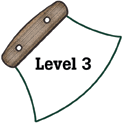
Alaska Science
Key Element C6
A student who meets the content standard should understand that scientific discovery is often a combination of an accidental happening and observation by a knowledgeable person with an open mind.
 |
Alaska Science A student who meets the content standard should understand that scientific discovery is often a combination of an accidental happening and observation by a knowledgeable person with an open mind. |
|
Performance Standard Level 3, Ages 11–14
|
|
|
|
Sample Assessment Ideas
|
Standards Cross-References
|
||
|
National Science Education Standards Recognize and analyze alternative explanations and predictions. Students should develop the ability to listen to and respect the explanations proposed by other students. They should remain open to and acknowledge different ideas and explanations, be able to accept the skepticism of others, and consider alternative explanations. (Page 148) Science advances through legitimate skepticism. Asking questions and querying other scientists’ explanations is part of scientific inquiry. Scientists evaluate the explanations proposed by other scientists by examining evidence, comparing evidence, identifying faulty reasoning, pointing out statements that go beyond evidence, and suggesting alternative explanations for the same observations. (Page 148) |
Benchmarks Scientific knowledge is subject to modification as new information challenges prevailing theories and as a new theory leads to looking at old observations in a new way. (Page 7) |
|
Table of Contents | Return to Alaska Native Knowledge Network